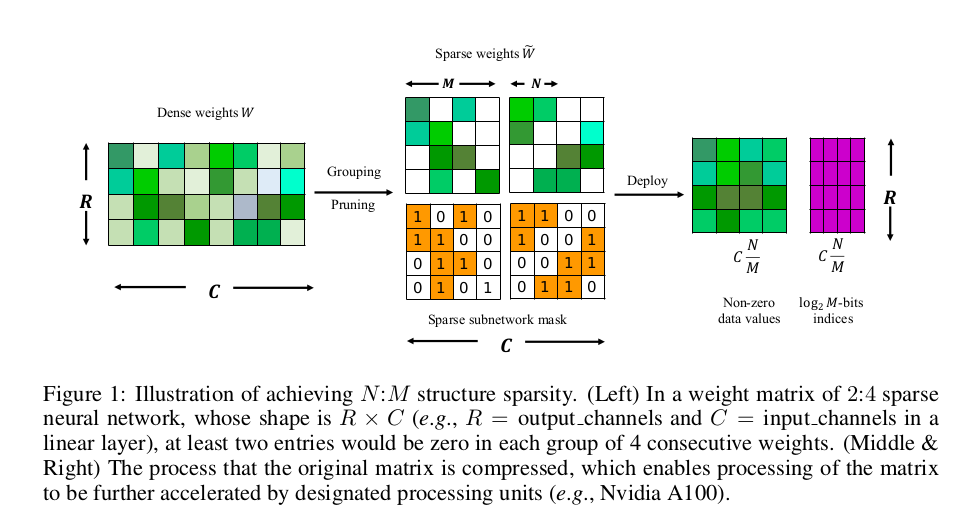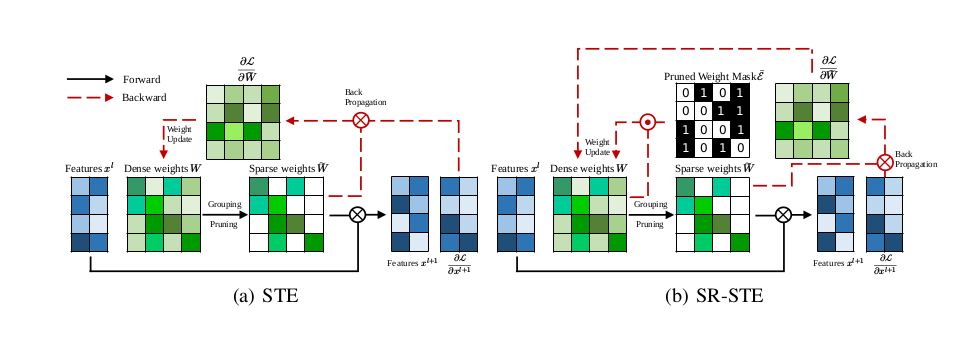Sparsity in Deep Neural Networks (DNNs) has been widely studied to compress and accelerate the models on resource-constrained environments. It can be generally categorized into unstructured fine-grained sparsity that zeroes out multiple individual weights distributed across the neural network, and structured coarse-grained sparsity which prunes blocks of a neural network. Fine-grained sparsity can achieve a high compression ratio but is not hardware friendly and hence receives limited speed gains. On the other hand, coarse-grained sparsity cannot concurrently achieve both acceleration on modern GPUs and maintain performance.
N:M fine-grained structured sparse network, which can maintain the advantages of both unstructured fine-grained sparsity and structured coarse-grained sparsity simultaneously on specifically designed GPUs.
The Nvidia ASP prune along channel dimensions, our original method prune alone kernel dimensions. Model Zoo
Latest NVIDIA Ampere GPUs design for 2:4 sparsity, For hardware acceleration, you can see the following resources:
How Sparsity Adds Umph to AI Inference
Accelerating Sparsity in the NVIDIA Ampere Architecture
Exploiting NVIDIA Ampere Structured Sparsity with cuSPARSELt
SR-STE can achieve comparable or even better results with negligible extra training cost and only a single easy-to-tune hyperparameter
the implementation details are shown as follows(https://github.com/NM-sparsity/NM-sparsity/blob/main/devkit/sparse_ops/sparse_ops.py):
class Sparse(autograd.Function):
"""" Prune the unimprotant weight for the forwards phase but pass the gradient to dense weight using SR-STE in the backwards phase"""
@staticmethod
def forward(ctx, weight, N, M, decay = 0.0002):
ctx.save_for_backward(weight)
output = weight.clone()
length = weight.numel()
group = int(length/M)
weight_temp = weight.detach().abs().reshape(group, M)
index = torch.argsort(weight_temp, dim=1)[:, :int(M-N)]
w_b = torch.ones(weight_temp.shape, device=weight_temp.device)
w_b = w_b.scatter_(dim=1, index=index, value=0).reshape(weight.shape)
ctx.mask = w_b
ctx.decay = decay
return output*w_b
@staticmethod
def backward(ctx, grad_output):
weight, = ctx.saved_tensors
return grad_output + ctx.decay * (1-ctx.mask) * weight, None, Noneclass SparseConv(nn.Conv2d):
"""" implement N:M sparse convolution layer """
def __init__(self, in_channels, out_channels, kernel_size, stride=1, padding=0, dilation=1, groups=1, bias=True, padding_mode='zeros', N=2, M=4, **kwargs):
self.N = N
self.M = M
super(SparseConv, self).__init__(in_channels, out_channels, kernel_size, stride, padding, dilation, groups, bias, padding_mode, **kwargs)
def get_sparse_weights(self):
return Sparse.apply(self.weight, self.N, self.M)
def forward(self, x):
w = self.get_sparse_weights()
x = F.conv2d(
x, w, self.bias, self.stride, self.padding, self.dilation, self.groups
)
return xIf you find NM-sparsity and SR-STE useful in your research, please consider citing:
@inproceedings{zhou2021,
title={Learning N:M Fine-grained Structured Sparse Neural Networks From Scratch},
author={Aojun Zhou, Yukun Ma, Junnan Zhu, Jianbo Liu, Zhijie Zhang, Kun Yuan, Wenxiu Sun, Hongsheng Li},
booktitle={International Conference on Learning Representations},
year={2021},
}

